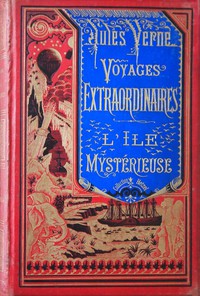The Mysterious Island by Jules Verne (ebook and pdf reader txt) 📖

- Author: Jules Verne
Book online «The Mysterious Island by Jules Verne (ebook and pdf reader txt) 📖». Author Jules Verne
EMUE. A species of cassowary found principally in Australia, and sometimes called Australian cassowary.
EUCALYPTUS. A genus of plants of the myrtle family, which grow to a prodigious height. Its leaves exude a substance resembling manna, which falls to the ground in pieces as large as nuts. The trees are sometimes called gum trees.
FEBRIFUGE. A medicine to drive away or allay fever.
FECULA. A term applied to the substance obtained from plants; also called starch or farina.
FULGURITE. A vitrified sand-tube made by the action of lightning.
FULIGINOUS. Resembling smoke; smokey.
FUSIFORM. Spindle-shaped.
GARGOYLE. A projecting water-spout, often grotesquely carved, attached to old gothic buildings.
HYDROGRAPHY. As opposed to orography; the water system of a country.
IZARD. The chamois of the Pyrenees.
JACAMAR. A genus of climbing birds, closely allied to the kingfishers, that live in forests, feed on insects, and build in low bushes. Their plumage has a carious metallic lustre.
JETSAM. Goods coming to land which have been thrown overboard from a ship in distress.
KAOLINE. The Chinese name for a kind of porcelain clay.
GLOSSARY.
KOULAS. See Ai.
LARDIZABALACEÆ. An order of twining shrubs, some of which furnish our greenhouses with pretty evergreen climbers.
LENTICULAR. Having the form of a double convex lens.
LIANA. A name used to designate the climbing, twining plants which abound in tropical forests, often growing to an immense size, and forming a perfect network of branches, impenetrable without the aid of a hatchet. They are comparatively rare in our climate, but honeysuckles may be mentioned as familiar examples.
LILIACKÆ. Plants of the order of amaryllids, growing to an enormous size. They are commonly known as the giant Lily. The stem is leafy, 15 or 20 feet high, and bears at the top a cluster of superb large crimson blossoms.
LITHODOMI. Molluscous animals which form holes in the solid rocks, in which they lodge themselves. One species (Lithodomus Lithophagus) is esteemed as an article of food, and is known by the name of the sea-date shell.
LORIES. Birds belonging to the parrot family, remarkable for their soft beaks.
MACAUCO. A genus of four-handed animals, resembling the monkey tribe.
MACRODACTYLS. Long-toed wading birds.
MAGOT. A small species of ape, sometimes called the Barbary ape.
MALACOLOGIST. One who treats of mollusks.
MANNIFERS. A name synonymous with mammals; meaning animals which suckle their young.
MANATEE. A marine animal closely related to the dugong. It Is sometimes called lamantine or sea-cow.
MARGARINE. A fatty solid matter obtained from oil.
MOUFFLON. Caprovis Mussimon. Resembling the mountain sheep of Arizona. It is the size of a deer; covered with hair which assumes a woolly character in winter.
OLEINE. The fluid portion of fats and oils.
ONAGER. Another name for the wild ass.
OROGRAPHY. As opposed to hydrography; the description of the mountain system of a country.
PALMIPEDS. Web-footed fowl.
PECCARY. An animal resembling a hog, sometimes called Mexican hog, or tajacu.
PELLICAN. A largo aquatic bird, having a long, straight and very strong bill. It lives upon fish, which It carries for some time in a pouch or bag attached to the lover mandible.
PIROGUE. A canoe, usually formed of a hollowed tree.
POLYPORUS. A genus of fungi, allied to mushrooms, toad-stools, sap-balls, etc.; used in Germany to make the tinder called Amadon.
PTEROPODA. A class of mollusks which live In the open sea, and have a pair of flippers or wings, by which they pass rapidly through the water.
PULP. The common name for marine animals of the genus octopus, such as the cuttle-fish. They have eight feet or arms around the head, with which they swim, creep, and seize their prey. It is the Pieuvre of Victor Hugo.
PUZZOLAN. Fine volcanic ashes, which harden under water, forming a kind of cement.
PYROXYLINE. Called also gun-cotton. It burns In the open air with a flash, though without smoke or report; but It is violently explosive when fired in a confined space.
QUADRUMANA. Animals having four hands, as apes, baboons, etc.
QUININE. The most important of the vegetable alkaloids found In the cinchona (see CINCHONIA). It is one of the most valuable antiperiodics and febrifuges known.
RECRUDESENCE. The state of becoming sore again.
RINFORDZANDO. A musical sign denoting an Increase of sound. Usually expressed by the abbreviation rf.
RUMINANT. An animal that chews the cud.
SAGOIN. A species of sapajo. The squirrel monkey; so called on account of its hairy tail.
SALICIN. A white and very bitter substance, obtained from the bark of the willow and other trees.
SAPAJOS. The proper name for tailed monkeys, as distinguishing them from apes, baboons and gorillas, which are tailless.
SEXTANT. An Instrument for measuring angles by reflection.
SPHENISCUS. Penguins; a sub-family of auks. Oceanic birds remarkable for their short legs, very short wings—which are useful only In swimming; and their upright position when at rest.
STEARINE. The most abundant of the solid constituents of fats and oils. Also a popular name for stearic acid, used in candles.
SUCCEDANEOUS. Supplying the place of something else.
TALUS. A sloping heap of fragments accumulated at the foot of a steep rock, from the face of which they have been broken off by the action of the weather.
TETRA. Tetraonieda, or grouse. The bird here described resembles the pinated grouse, or prairie-chicken.
TINAMONS. A family of birds belonging to the order gallinæ. They are about the size of quail.
TOURACO-LORIES. Climbing birds of the parrot family.
TRAGOPANS. A large species of pheasant.
TUFA. A name given to volcanic dust, cemented by the Infiltration of water into a porous rock.
[Illustration: Lincoln Island]
END OF TRANSLATION OF THE MYSTERIOUS ISLAND End of the Project Gutenberg EBook of The Mysterious Island, by Jules Verne Have you ever thought about what fiction is? Probably, such a question may seem surprising: and so everything is clear. Every person throughout his life has to repeatedly create the works he needs for specific purposes - statements, autobiographies, dictations - using not gypsum or clay, not musical notes, not paints, but just a word. At the same time, almost every person will be very surprised if he is told that he thereby created a work of fiction, which is very different from visual art, music and sculpture making. However, everyone understands that a student's essay or dictation is fundamentally different from novels, short stories, news that are created by professional writers. In the works of professionals there is the most important difference - excogitation. But, oddly enough, in a school literature course, you don’t realize the full power of fiction. So using our website in your free time discover fiction for yourself.
Have you ever thought about what fiction is? Probably, such a question may seem surprising: and so everything is clear. Every person throughout his life has to repeatedly create the works he needs for specific purposes - statements, autobiographies, dictations - using not gypsum or clay, not musical notes, not paints, but just a word. At the same time, almost every person will be very surprised if he is told that he thereby created a work of fiction, which is very different from visual art, music and sculpture making. However, everyone understands that a student's essay or dictation is fundamentally different from novels, short stories, news that are created by professional writers. In the works of professionals there is the most important difference - excogitation. But, oddly enough, in a school literature course, you don’t realize the full power of fiction. So using our website in your free time discover fiction for yourself. 




Comments (0)